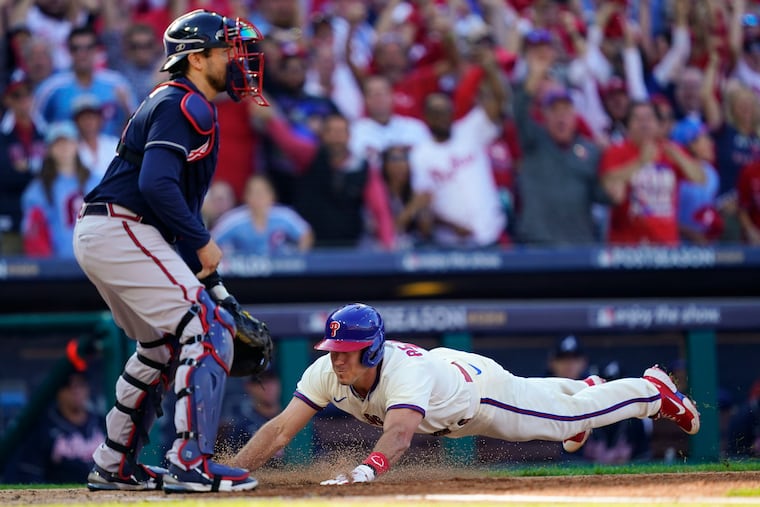How Citizens Bank Park’s design helped J.T. Realmuto make history
Ed Wade and the Phillies brass at the time wanted Citizens Bank Park to be different from the Vet. It sure has been.

The ball took a sideways bounce off the wall as though it were defying the laws of physics, and the centerfielder scurried after it as if he were chasing a puppy who just ran out the back door.
By the time the Atlanta Braves’ Michael Harris II caught up to the white object rolling away from him, Phillies catcher J.T. Realmuto was sprinting his way to baseball history, becoming the first catcher to hit a postseason inside-the-park home run.
It was an improbable exclamation point on the day the Phillies improbably advanced to this National League pennant series with the San Diego Padres, which returns to South Philly on Friday night.
As chaotic as that carom might have appeared, it was the result of what could be viewed as designed chaos.
It was a moment to savor for one of the spectators, Richard Deats, a former Phillies executive who had a lot to do with the configuration of that wall. “That’s what it was designed for,” he said Thursday, “to see plays like that.”
Having played three decades in a cavernous, concrete bowl situated in an urban prairie and that had all the atmosphere of the moon, the Phillies were ready for a change of venue, and they wanted their new home to be “asymmetric ... entertaining,” recalled Ed Wade, who was the team’s vice president and general manager.
Wade was another key figure in the planning of what became Citizens Bank Park, which opened in April 2004 just days after the Vet was imploded. “We didn’t want it to mirror Vet Stadium by any stretch of the imagination,” he said last week.
It didn’t.
About the homer
The differences in the two stadiums were dramatically evident in the third inning Saturday when Realmuto hit a shot against the left-centerfield wall near the 409-foot marker. That is the deepest part of the park, beating centerfield by 8 feet. At the Vet, dead center was the farthest point from home plate, a long-standing baseball protocol.
At the Vet, the left- and right-field fences curved smoothly toward center. At CBP, the fences give way to walls that rise as high as 19 feet as they approach center and converge at odd angles, almost as though the architect somehow misdrew a line or two.
As Harris, the centerfielder, reached the padded wall, his quarry ricocheted toward right field, and if the Braves had the sensation that they were watching their season roll away, it was no illusion.
“Different angles create different scenarios,” said Wade, who credited the late team president Dave Montgomery for being open to suggestions when the planning was underway. “We talked about fence heights, and having it be asymmetric,” Wade said.
Deats said Montgomery was all for angles that would make extra-base hits more adventurous. Montgomery had grown up watching baseball in an era when games were played in quirky venues such as New York’s Polo Grounds, where during the 1954 World Series a 475-foot fly ball turned into an out, and a Giants batter hit a game-winning homer that traveled all of 260 feet.
In the 1960s and ‘70s, teams building new parks, such as the Phillies, opted for symmetry, with dimensions the same in right and left fields.
By the turn of the millennium, baseball organizations had figured out that symmetry was a false god, that having uniform distances in stadiums actually was unfair because having the same dimensions in left and right fields failed to take into account the impacts of prevailing winds.
In Philadelphia, they favor lefthanded hitters. The right-field foul pole is about a foot closer to home than its left-field counterpart, and the fence nearly 3 feet higher.
A watershed moment in ballpark design occurred in Baltimore, ironically the site of one of the early symmetrical stadiums, Memorial Park. It was replaced by the throwback Oriole Park at Camden Yards in 1992.
It was a sensation, and one of the models used in the CBP design, Wade said.
Rarities
Given that it happened in the postseason, Wade said that Realmuto’s shot is something for the CBP planners to savor in that it “draws attention to what we were trying to do, which is create a ballpark that is both competitive and entertaining.”
An inside-the-park home run is a rarity at any time of the season, by Major League Baseball calculations. On average, a ballpark can expect to see one once every two to three years.
Before Realmuto’s, Kansas City’s Alcides Escobar hit one during the 2015 World Series that the Royals won over the New York Mets.
It cuts both ways
The CBP quirkiness bit the Phillies in June 2020, when then-Washington Nationals shortstop Trea Turner banged a fly ball off the angled right-centerfield wall off Zach Eflin and circled the bases.
Although at the time the Nats were the defending champs, this wasn’t all that dramatic as Realmuto’s.
As opposed to Saturday, when the 43,000-plus on hand in South Philly pushed decibel readings into dangerous territory, CBP was stone silent.
The stadium that day was COVID-empty and packed with cardboard cutouts.